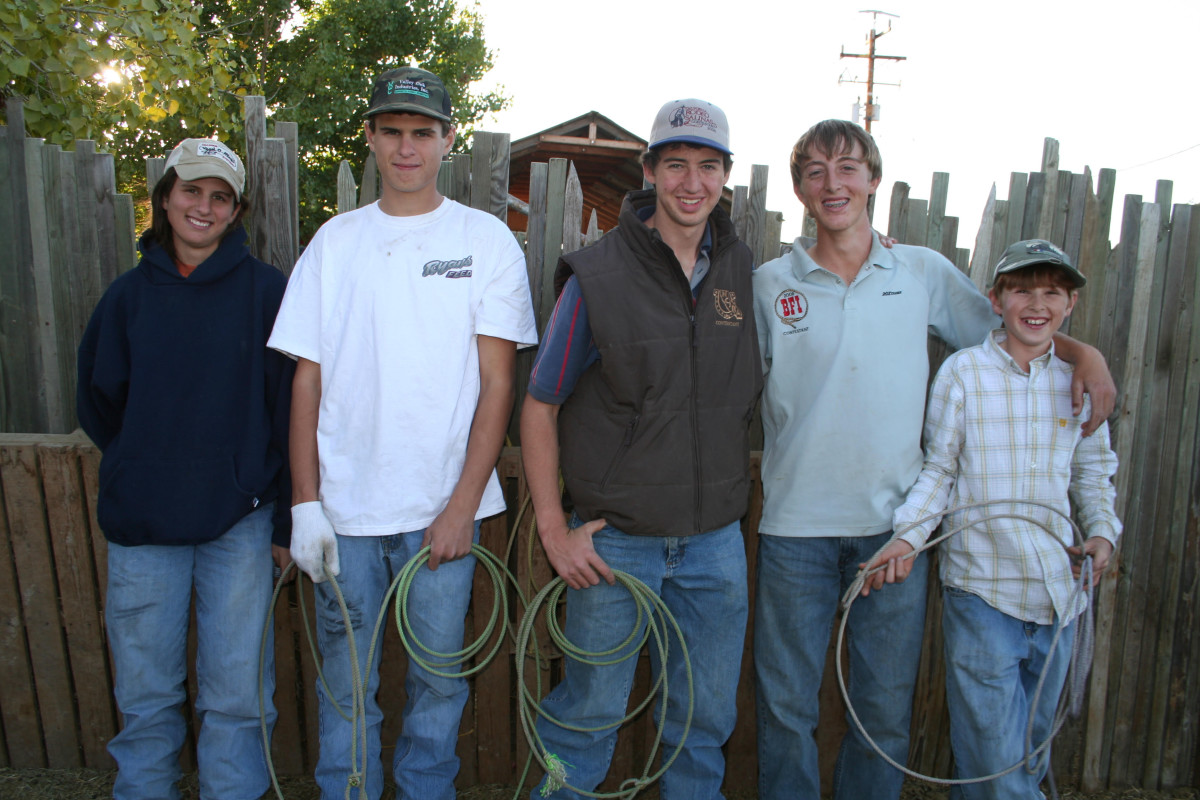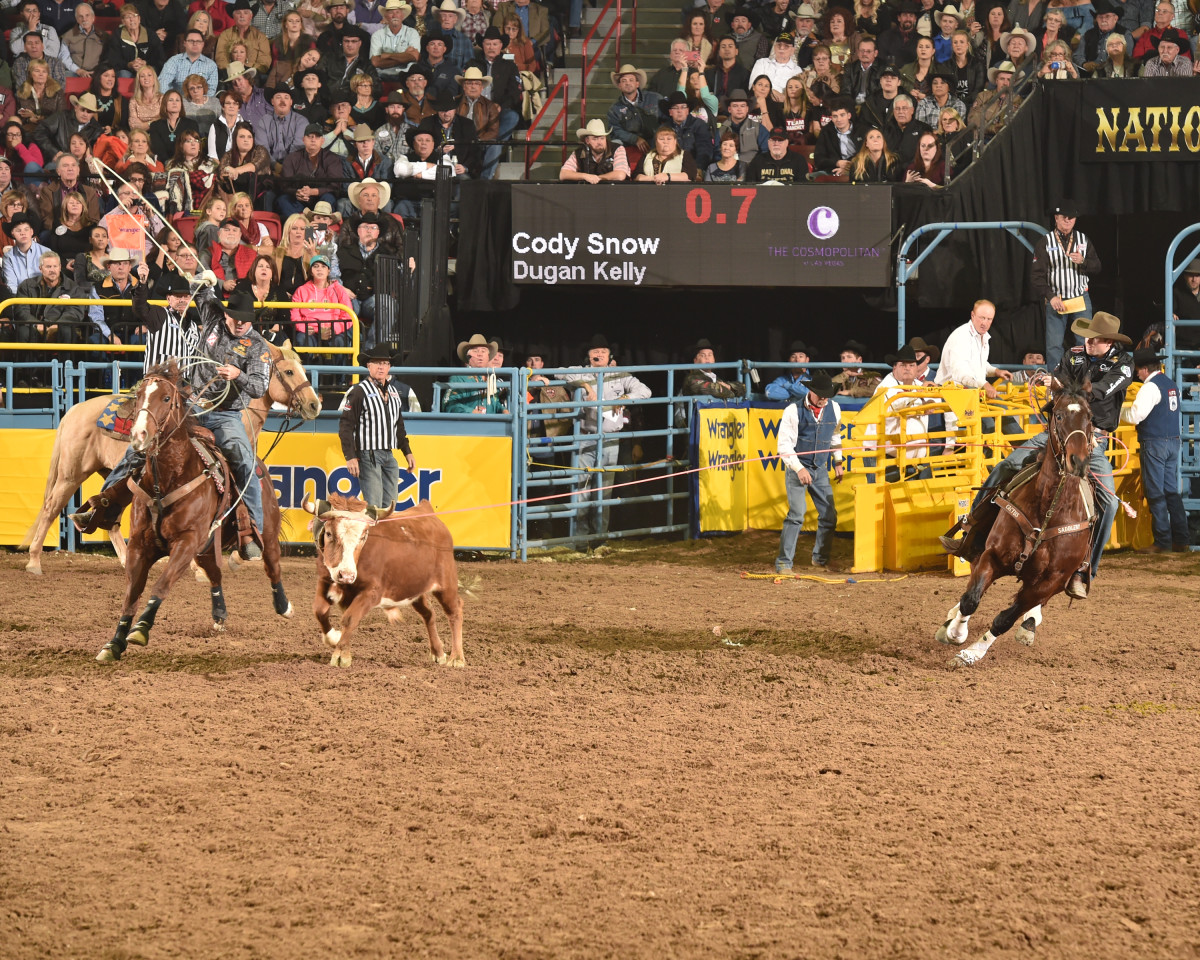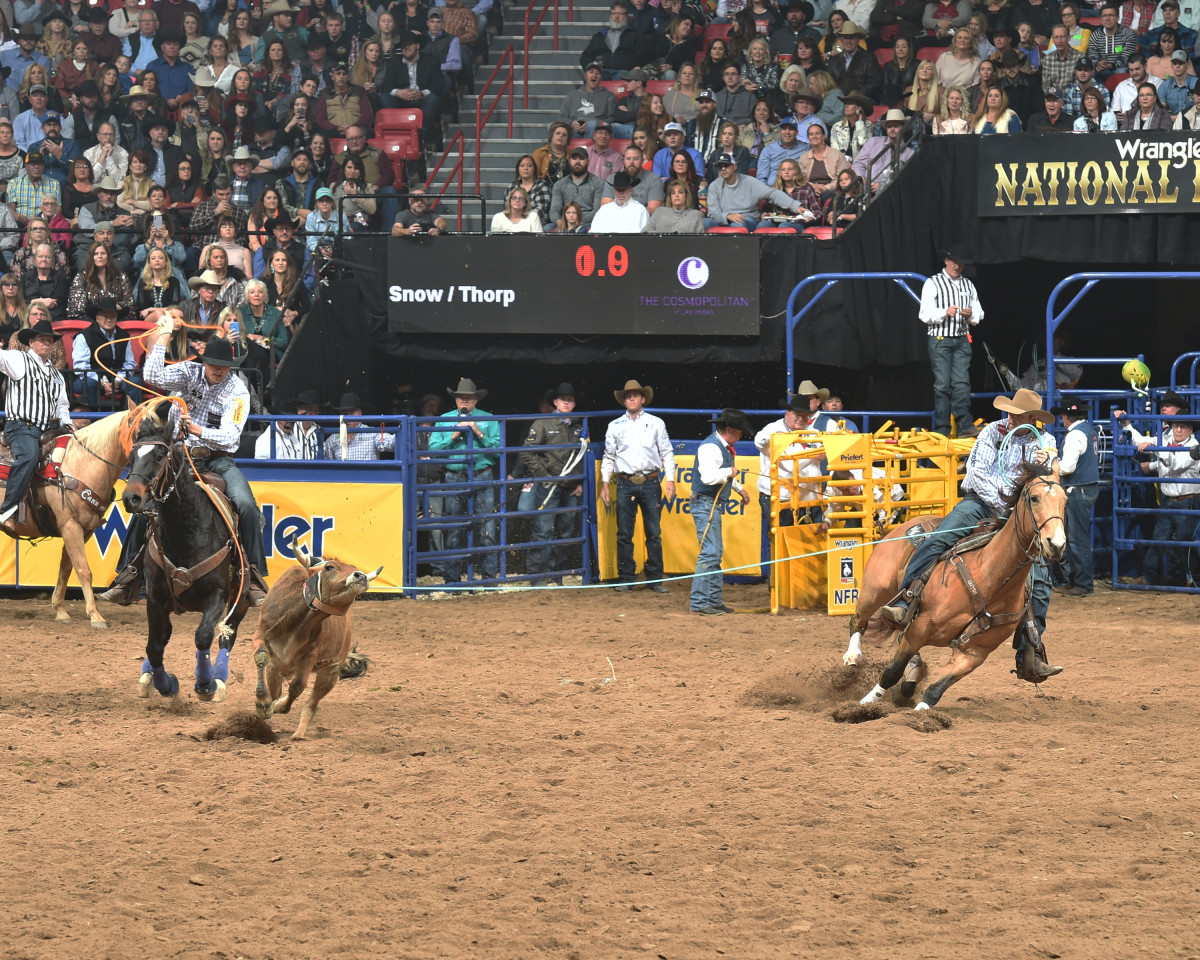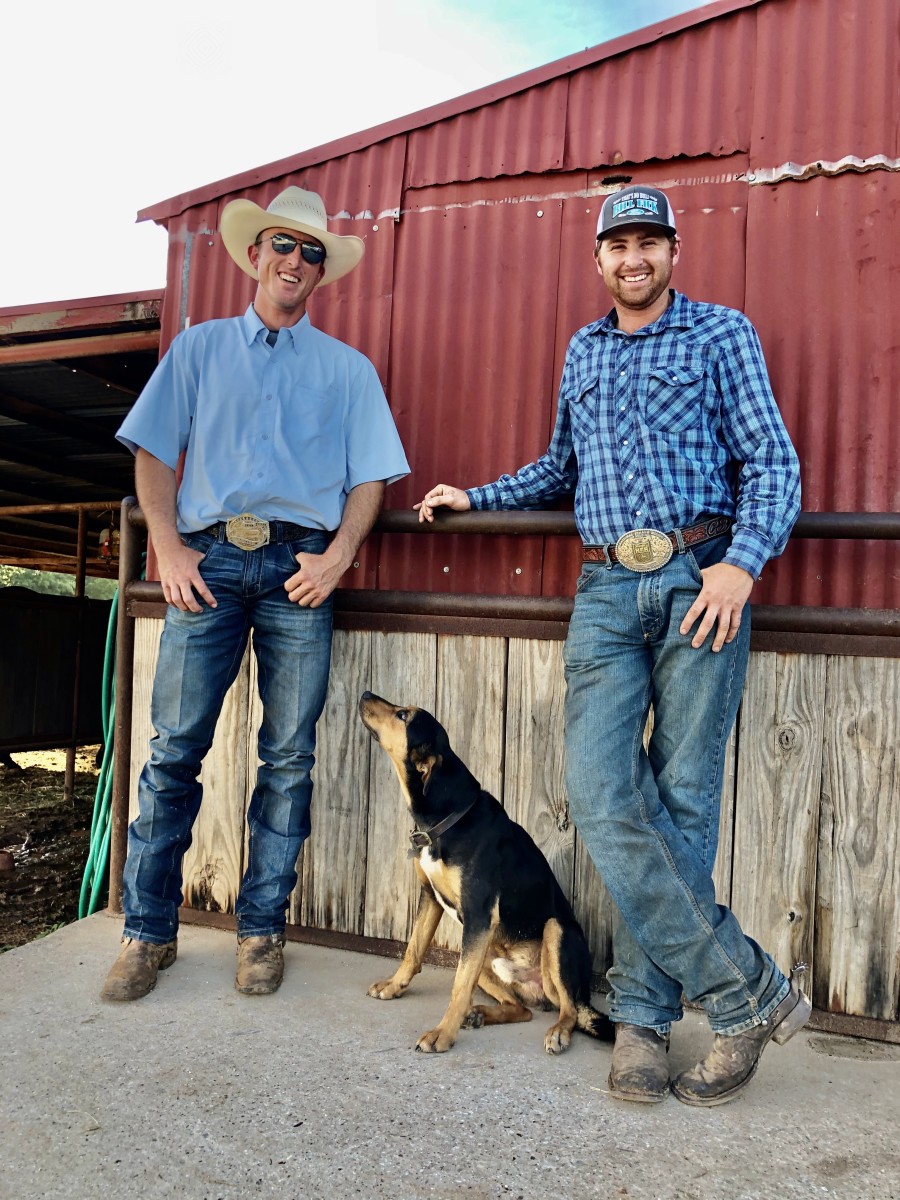I’ve had a front-row seat to Cody Snow’s Wild West Show since the start. What a privilege to get to experience the ride first-hand. People sometimes ask if I saw Cody’s greatness—including winning the Wrangler National Finals Rodeo team roping average last December with Wesley Thorp, and helping Wesley win the world—coming. While I’m not going to lie, the kid did give me a few gray hairs in the early days, no, his rise to the top of the roping ranks does not surprise me. And having been there for some of the highest highs and lowest lows of his life, I must say that the Snowman’s success could not possibly delight any of us who watched him grow up more.
Cody headed for my son Taylor in junior high and high school. When they needed to be 7 or 8 to win the average, Cody knocked it out of the latch, dropped a coil and tried to be 4 or 5. It didn’t always work, but Cody never backed down from trying again next time. Some of the rodeo dads loved looking over at me for a reaction. I just smiled and headed back to the motorhome to cook lunch or dinner for the home-team troops, which in their childhood also included Taylor’s big brother, Lane.
[SHOP: Cody Snow’s Team Roping Gear]
Cactus Relentless All-Around Sport Boots
(As an Amazon Associate, we earn from qualifying purchases made through affiliate links.)

Cody Snow’s Wild West Show really was a thing, and going all the way back included buying, selling, training and trading horses, cattle, pigs, donkeys, goats, chickens, rabbits and anything else that moved and maybe had a tail. Cody was a fearless, fierce competitor and handy horseman by birth. He also was born with a brilliant mind for business and making money.
Cody grew up in Los Olivos, California, in the scenic Santa Ynez Valley, the son of renowned equine veterinarian and champion aerobatic pilot Van Snow, who died in a 2010 plane crash at 58—when Cody was 13. Van and Loree’s daughter, Shelbie, recently graduated from vet school. She and Cody have four half siblings—April, Amy, Hayley and Tye—from Van’s first marriage.
Cody’s 23 now, and is neighbors with Lane and Taylor in the current Cowboy Capital of the World in Stephenville, Texas. We got together for a visit one evening earlier this summer in Cody’s tack room.
Kendra Santos: So many people in the Western world remember your dad so fondly as a loyal friend and respected leader in his field. I remember the two of you being inseparable. What are the most valuable lessons learned from your dad that you carry with you today?
Cody Snow: My dad was very disciplined and passionate about everything he did. So if I ever half-assed anything, he was on me. Why he was hard on me like that makes a lot of sense to me now. My dad taught me how to be self-driven. He told me that whatever you do, you have to be the best at it to be successful. I’m always working to be more efficient and more consistent. Not giving it all they have holds a lot of people back.
Q: Your mom is amazing also. Describe Loree Snow Armenta for those who don’t know her.
A: My mom has always been really supportive. She’s never held me back from doing what I wanted to do, and she’s always so positive. My dad was so competitive, and he bred it into me to be passionate about whatever I do. My mom has always helped me lighten up a little.
Q: Take us time traveling on your professional roping career. You weren’t on your permit very long, were you?
A: No. I roped with Dalton Pearce at Brawley (California), and we didn’t do any good. Then I roped with T.J. McCauley at Tucson (Arizona), and filled my permit right there. I was already entered at Glen Rose (Texas) with Wesley, and we won that. So I went to three rodeos on my permit, then bought my (Professional Rodeo Cowboys Association) card right after Glen Rose. My next rodeo was Logandale (Nevada). That was the first rodeo on my card, and I roped with Dugan Kelly.

Q: You were the 2015 Resistol Rookie Header of the Year, and have roped at the Finals the last four straight years, from 2016-19. You roped at your first NFR with Dugan, then three in a row with Wesley. I know you guys are forever friends. What did you take away from those two partnerships?
A: I didn’t know anything about rodeoing when I started roping with Dugan. I’d been to less than 10 open rodeos before I started roping with him. He taught me so much. My routines I have now—how I travel and take care of things—came from what Dugan taught me. Wesley and I were the same age and had the same goals. We both wanted to get as good as we could. Roping is all we wanted to do, and we worked at it every day. We pushed each other pretty hard.
The BENEFITS of a team roping Warm-Up Routine with Cody Snow
Q: With your help, Wesley won the world last year. Ironically, you had $7,757 more won than Wesley after he stayed home from the California spring run for the birth of baby Charlie, and you won a lot—including the W at Clovis—with Hunter Koch. Yet Clay Smith won his second world title, and you were the reserve world heading champ (Clay’s 2019 earnings were $268,820; Cody’s were $256,938; Wesley’s were $249,181; and reserve heeler Junior Nogueira’s were $238,243).
A: Winning the average at the Finals was a goal I had set, and something I always wanted to win. So it was a big relief to accomplish one of my main goals. I was proud of Wesley winning the world, and I’m happy I could help him get there. We worked hard together.

Q: Let’s talk 2020. Besides the coronavirus canceling all kinds of rodeos, you’ve had a variety pack of partners.
A: Yes, I headed for Travis Graves at a couple rodeos early on in the 2020 season. I entered Waco (Texas) with Cesar de la Cruz, and we won second in the average there. I roped with Paul Eaves at Odessa (Texas), Denver (Colorado, which they won), and the Texas rodeos in San Angelo, Fort Worth and Houston. Now I’m roping with Junior (Nogueira).
Q: When exactly did you join forces with Junior, and how excited are you about it?
A: Once the corona deal hit, we all took a break. Then I came back with Junior the first week in June. Our first pro rodeo was in Mesquite (Texas). We were 3.9, and won it. Junior’s one of the best heelers ever. He’s a winner, and he tries hard. It’s hard to beat someone who tries as hard as he does and wants it as bad as he does. Junior expects to win. His mind thinks “win” all the time. That gives me confidence.
Q: You always name Jake Barnes as your heading hero. I mentioned your name to Jake the other day, and he called you “a force.” Knowing that your dad and Jake were good friends, and that Jake roped with Junior when he first arrived in America from Brazil, this partnership feels like a pretty fitting twist of fate.
A: Yes, I got to be around Jake when I was a kid. His great gray horse, Barney, was at our house when my dad took that rock out of his knee. I try to pick things up from every person I watch rope, but I got to be around Jake a lot and I’ve always liked his style. Jake’s really aggressive, but he’s also consistent.
Q: You haven’t had very many full-time roping partners in your lifetime. You haven’t had all that many horses in your personal herd, either. First there was Blondie. Then there was Bo and Burt. At 17, Burt’s still your main man. Only now, he travels side-by-side with Annie, who’s 12. As a guy who works on his horsemanship all day, every day, talk about that fab four.
A: Blondie was my first head horse, then I roped calves on her, too. She was a once-in-a-lifetime kind of horse. It takes one horse to teach you how to do things right, and Blondie did that. She trained me. Bo was really good, too. Those two and Burt raised me. I bought Burt from my mom when he was 6, so Burt’s been with me since my first real rodeo. I rode him in junior high, and I still ride him. He got me to my first NFR. I bought Annie when she was 4, and got to make her exactly how I wanted one. Blondie, Bo and Burt taught me what I wanted in a horse, and I got to apply that to a horse that had a ton of talent. Annie’s so honest. She gives me a chance to win every time. I can’t think of one thing I’d change about her.

Q: What’s the ticket to horsemanship?
A: Getting a horse broke early on is important. I admire that, and it’s what I want to do. The better handle you have on your horse just riding him or her around, the more you can do during the run. A lot of horses would be a lot better if they understood what they’re supposed to do. They need to savvy what you’re asking of them and what your cues mean before there’s a steer involved. It all goes back to fundamentals. If they can’t do it riding around, it’s really hard for a horse to do it at high speed on a steer.
Q: Not many guys ride the same horse at the tiny Thomas & Mack Center as they do over the long score at Salinas. But you do.
A: The horses I rodeo on are diverse. My run is the same in every size of arena, so I want a horse I can win on in every situation. If I asked you to haul my horse to me, and you loaded up either Annie or Burt, I wouldn’t be mad. They’re both good everywhere.
Q: Is this rodeo life everything you dreamed it would be when you were a kid?
A: I never pictured any other life. This is what I’ve always wanted to do. It’s pretty fun getting to rope every day. Roping doesn’t feel like a job to me. It’s something I get to do, not something I have to do. Everyone’s goal is to win the world. My goal is to be the best I can possibly be.









